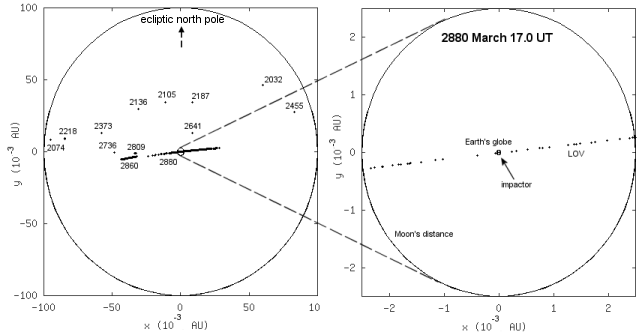
First figure presents the next 13 close encounters with the Earth (occuring in 2032, 2074,... and 2880) of this kilometer-sized asteroid. Projections of the uncertainty region on the target plane at 3 sigma are depicted (left panel), using for this a Monte-Carlo numerical propagation method. In 2880 this region will become quite large and on March 17.0 UT it will interesect the Earth's globe (right panel).

A virtual impactor has been found (from 300 sampling points), with the following initial conditions (keplerian elements):
The integration was performed with the following dynamical model adopted for the solar system:initial epoch: 2002 May 6.0 (JD 2452400.5)
reference system: J2000.0a: 1.69862447274562 (AU) O: 356.81833114065651 (deg)
e: 0.50759081183113 p: 224.49958569864942 (deg)
I: 12.18463273493380 (deg) M: 172.78247310122810 (deg)
- the Sun (with relativistic effect)
- 9 major planets
- the Moon
- 3 largest asteroids
No radiative or thermal forces have been included!
This is the orbit of the asteroid (the elongated one), together with the orbits of Venus, Earth and Mars. The asteroid passes near the Earth's orbit every 2.2 years at the descending node. Each year, on March, the Earth passes also near this point, but very seldom together with the asteroid.
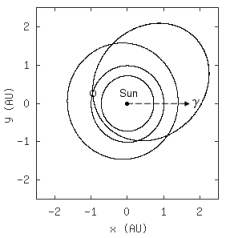
This is the minimal orbital intersection distance (MOID) between the orbit of the asteroid and that of the Earth. It shows a short-time orbital approach near 2880, when the orbits do intersect each other.
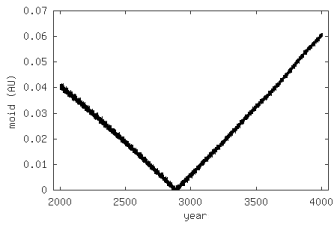
The dispersion along the orbit between the asteroid and a virtual image of it suggests a quasi-regular motion for the first part of this two thousands years of evolution. The overall Lyapounov time is estimated numerically at about 50 years. The 2880 close encounter marks the transition between the regular and chaotic motion.
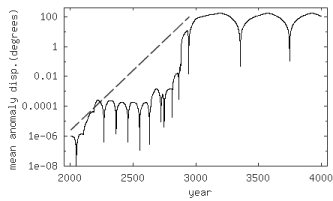
The asteroid is located near 5:11 mean motion resonance with the Earth, as it is suggested by the libration of the resonant argument. This resonance might be responsable for the quasi-regular motion pointed out above. Close enounters near 2880 will remove the asteroid from this resonance.
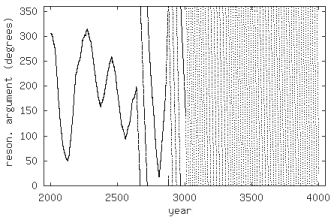
References:
- Berinde, S.: 2001. "The SolSyIn package - An integrator for our solar system", Internet Release (http://math.ubbcluj.ro/~sberinde/solsyin)
- Berinde, S.: 2002. "The origin and evolution of celestial bodies gravitating in the vicinity of Earth's orbit", Doctoral Thesis, Babes-Bolyai University, Cluj-Napoca.
- Chesley, S.R. and Milani, A.: 1999. "NEODyS - An online information system for near-Earth objects", (http://newton.dm.unipi.it/neodys)
- Giorgini, J.D. et al.:
2002. "Asteroid 1950 DA's encounter with Earth in 2880: Physical
limits of collision probability prediction", Science, 296, p. 132